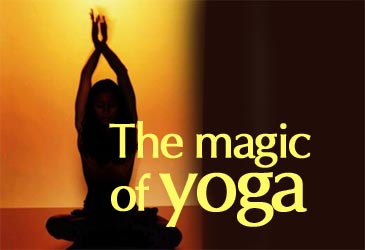Do You Believe In Magick Part 6
Cynthia Pawl Exposing Satanism and
Witchcraft January 30, 2016
--
 |
EASTERN
RELIGION WORKS ITS MAGICK
----
|
As scientific agendas,
formulas and theories became more dominant, people came to question all things
religious. A new atheistic movement emerged. The world was too sophisticated to
believe in spirits and demons.
A writer named Sam Harris published a book called The End of Faith. Mr. Harris,
along with other writers like Richard Dawkins, Christopher Hitchens and Daniel
Dennett, Harris forged an unapologetic attack on all literalist religious
beliefs. To their thinking, this New Atheism provided a clear defense of reason
against fundamentalisms, which to them seemed to only look backward. Sadly, they
also dismissed all other experiences of "spirituality" as worthless
idle-headed confusion.
In an item called the
2012 survey by the Pew Religion and Public Life Project it was discovered
that 20 % of Americans consider themselves to be “Spiritual but not
religious.” Actually, in our modern society, so many Americans describe their
belief system this way that pollsters have given this group their own category
on questionnaires.
These folks want some connection to the divine, but reject traditional religion.
They proudly proclaim this, as if were some outlandish new mindset that had
never been explored. They are in rebellion against the religious status quo. The
reject the old standardised structured assemblies, and prefer to commune with
God in nature. They feel closest to God when staring at the sunset or walking on
the beach. They want nothing to do with the traditional version of God and
Church. They may like the teachings of Jesus, he might even be view him as a
great messenger or guru, but they do not accept Jesus as God.
They willingly participate in just about anything and everything else, from
mystical discussion groups to drumming circles, to yoga classes. They are only
interested in self-development and fulfillment and believe they don’t need
history, and are not interested in the past. They see religion as something that
needs to remain in the past, while they move through the present into the
future.
You can generally find them in the shiatsu massage clinic, visiting an
acupuncturist, or out in a remote desert participating in the "Burning
Man". They are immensely drawn to any type of artistic expression, from
carving and painting to music and dance.
They want to be free to allow their personal spirituality to take them wherever
it leads. Meditation and chanting are their sacred activities. They fully
embrace science's promise of knowledge based on evidence. They see their lives
as an ever expanding sensual adventure, which they perceive as spiritual. They
struggle to meld their own spiritual experience with science. They anxiously
await the day when they can be implanted with super human powers.
More and more the faith of our fathers is being is being tossed away, like some
worn out garment, leaving a great spiritual void. People are scrambling to find
something to hold on to, that can bring peace, security, and meaning to their
lives. Naturally, this leaves an opening for all kinds of spiritual influences.
We all know that nature abhors a vacuum. When our western culture began to feel
the emptiness brought about by their loss of faith, there was no shortage of
forces eager to move in and fill the void. Eastern Philosophy/Religion has been
one major force that has captured the hearts, minds and souls of our society.
1st Introduction:
The western public had its first exposure to Yoga and other Indian philosophies,
around the middle of the 19th Century. Treatise on Yoga Philosophy in
1851.
This was the first time anyone had actively advocated and disseminated aspects
of yoga to a western audience. The growing interest of the day's intellectuals
in all things Transcendental provided a receptive audience.
19th Century Theosophists
hungry for the hidden knowledge of God and nature, also had a large influence on
the American public's view of Yoga. Esoteric views of that century provided a
greater reception of Yoga and of Verdant, due to its theory and practice of the
correspondence between the spiritual and the physical.
(Vedanta is based on the Verdas, one of the world’s broadest and most ancient
religious philosophies. The Vedas are the sacred scriptures of India. They affirm
the oneness of existence, the divinity of the soul, and the harmony of religions.
Vedanta is not specifically Indian though it include much of the philosophical
foundation of Hinduism which includes aspects of Indian culture. Vedanta is
universal and can be applied to all cultures and nations of all types of
religious backgrounds.
As we examine the etymology of the word “Vedanta” we find it is a
combination of two words: “Veda” which means “knowledge” and “anta”
which means “the end of” or “the goal of.” The goal of knowledge, in
this context does not imply intellectual knowledge (they kind we acquire by
reading books). It refers to the knowledge of God, and perhaps more accurately
the knowledge of your own divine nature. Vedanta is the search for
Self-knowledge as well as the search for God.
According to Vedanta,God is not an entitiy but an infinite existence, infinite
consciousness, and infinite bliss. The term for this impersonal, transcendent
reality, or spiritual force, is Brahman, the divine ground of being. Verdanta
also teaches that this Brahman manifests in human form during every age.
The divine Self or Atman, God dwells within our own hearts. It is never born and
will it ever die. It is not affected by our failings or body fluctuations, or
variances of the mind. Emotions, diseases, despair or ignorance have not affect
upon it. The Atman is perfect purity, free from limitations, According to the
Verdanta the Atam is one with Brahman and the human heart is its temple. The
goal of the human life is to fully realize their God potential and manifest
divinity. That is their purpose, and it matters not if one reaches that goal in
this life or future lives.
See more info here: http://vedanta.org/vedanta-overview/)
In the 19th and early 20th centuries western culture was caught up in Tantric
Yoga. (Tantrism and Tantric religion, is an ancient Hindu tradition of
beliefs and meditation and ritual practices that seeks to channel the divine
energy of the godhead into the human body, to the end goal of realizing their
divinity. Dating back 5,000 years, Tantric sex is an ancient Eastern spiritual
practice practiced for the purpose of enlightenment. In the Tantric view, when
Shiva, male energy, and Shakti, female energy, come into a sexual union, the
practioner is believed to be at the highest point of enlightenment.
Starting in 1928, Yoga began to be considered as a science, by western culture.
Yoga began to be promoted as excercise, in the early 21st century, with Hatha
yoga and its asanas
(postures). (Hatha yoga is actually the first, and most essential aspect of the
eastern spiritual process. The purpose of the discipline is to prepare the body
to move into the higher levels of the spiritual experience. Ha meaning “sun”
and tha meaning union, it functions as ying and yang to bring union to the
opposite aspects of the individual, to build strength and endurance, and learn
breath control. This is the yoga that most westerners are familiar and though it
may be touted as a purely physical endeavor, you should be assured it is fully
spiritual. You cannot isolate one aspect of this discipline, all parts of the
eastern religion build upon the other. Hatha is the gate.
The American public began to recognize the spiritual aspects of Yoga and its
repercussions, during 1910s and 1920s. This resulted in a period of bad
publicity and a number of scandals associated with Yoga. American’s began to
become wise to the fact that they had been duped into opening themselves up to
spiritual things about which they had no real knowledge and which were dangerous
and detrimental to their well being.
Celebrity endoresements were employed in the 1930s and 1940s to overcome the
negatives, and encourage more public acceptance of yoga as excercise with some
success.
But in the 1950s, America experienced another period of disenchantment yoga and
its negative aspects. Once again, the people began to become wise and turn away
from this evil influence.
But, the Hippie movement of the 1960s with the drugs, rock and roll, and open
rebellion, brought a renewed interest in Hindu spirituality. There sprung up
great number of Neo-Hindu schools, specifically targeting the western public. As
people began to focus on good health, Yoga was once again falsely presented as a
harmless form of exercise.
In 1969, Kundalini Yoga was introduced to the United States. Comprehensive,
classical teachings of Ashtanga Yoga, Samyka,
the subtle body theory, Fitness Asanas, and tantric elements were now included
in the yoga training, in the United States and Canada. Kundalini is the most
horrendously evil portion of the eastern disciplines. This will be presented in
more detail further in this article.
Again in the 1980's yoga experience a burst of interest. The culture was now
highly focused on exercise and good health and yoga was being portrayed as
having great benefits to heart health. The nation saw many suffering from heart
diseases and deaths, so folks were eager to believe yoga as a purely physical
system of health exercises. Numerous asanas (positions) seemed modern in origin,
and not unlike 19th and early-20th century Western exercise traditions.
Foolishly, everyone failed to recognize that there is no way to remove the
eastern religious aspect from the physical training.
Currently the American
College of Sports Medicine supports the integration certain types of yoga
into the some exercise regimens, of healthy individuals, but only as long as
properly-trained professionals deliver instruction. The College cites yoga's
promotion of "profound mental, physical and spiritual awareness" and
its benefits as a form of stretching, and as an enhancer of breath control and
of core strength.
There is a saying: “There is no Yoga
without Hinduism and no Hinduism without Yoga."
Continued in Part 7 - Eastern
Works its Magic continued



